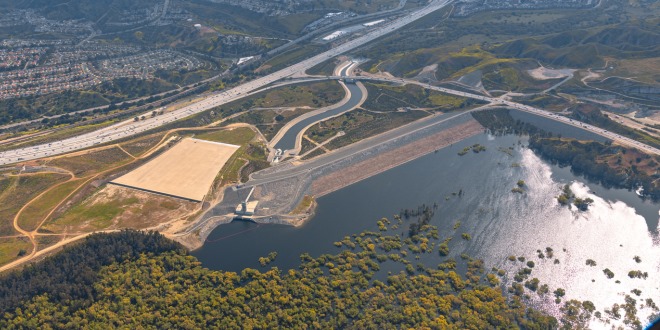There is something to be said for updating the way California manages its water resources. A new report released from the U.S. Army Corps of Engineers, the Center for Western Weather and Water Extremes, (CW3E) and the Orange County Water District says just that.
The Prado Dam FIRO Final Viability Assessment, released last month, describes how Forecast-Informed Reservoir Operations (FIRO) at Prado Dam can allow operators to increase the volume of storm water that is temporarily stored behind the dam and then released later at a rate that allows recharge into the Orange County groundwater basin to enhance water supply.
The study showed FIRO operations at Prado Dam is expected to increase average storm water recharge by 8 to 11 percent or an average annual increase of 4,000-6,000 acre-feet of groundwater recharge. More impressively, in a wet year, FIRO operations could provide up to 23,000 acre-feet of additional recharge.
“FIRO pilot sites like Prado Dam add valuable experience to our agency’s understanding about how to implement FIRO in various kinds of watersheds and reservoirs, enabling us to find better balances between multiple authorized purposes such as flood-risk management, water supply and ecological benefits at our reservoirs,” said Cary A. Talbot, with the U.S. Army Engineer Research and Development Center and FIRO program national lead for the Corps. “FIRO is also a powerful tool in adding flexibility to water management practice that improves the resiliency of existing infrastructure to better face the challenges presented by a changing climate”
The U.S. Army Corps and CW3E are conducting studies at additional sites as part of a broader assessment including Seven Oaks Dam in San Bernardino, Calif., and Howard Hanson Dam near Seattle, Wash., with a nationwide screening process underway.
Advances in atmospheric river forecasting, supported by CW3E’s Atmospheric River Reconnaissance program that collects data on these storms from Air Force and NOAA “Hurricane Hunters,” and partnerships including California’s Department of Water Resources, have significantly improved forecast reliability, aiding dam operators in effective water management.
“This FVA represents the second completed FIRO assessment, and like the first, demonstrates the positive impacts of using atmospheric river forecasts to enhance operational flexibility at a major dam,” said Marty Ralph, Chief Scientist for the FIRO National Expansion Pathfinder and Director of CW3E. “These scientific and engineering results are a key milestone towards incorporating FIRO more formally into the future rules that govern Prado Dam operations. The success of FIRO hinges on improvements in forecast skill and that skill is founded on scientific knowledge, specialized observations, and specialized forecast tools. Further advances in forecast skill are likely to enable greater flexibility in the future as we better anticipate where and when ARs will strike.”
The FIRO strategy will now be tested at Prado Dam over the next several years with the goal of making this a permanent feature by 2027.
 California Water News Daily Your Source For Water News in California
California Water News Daily Your Source For Water News in California


